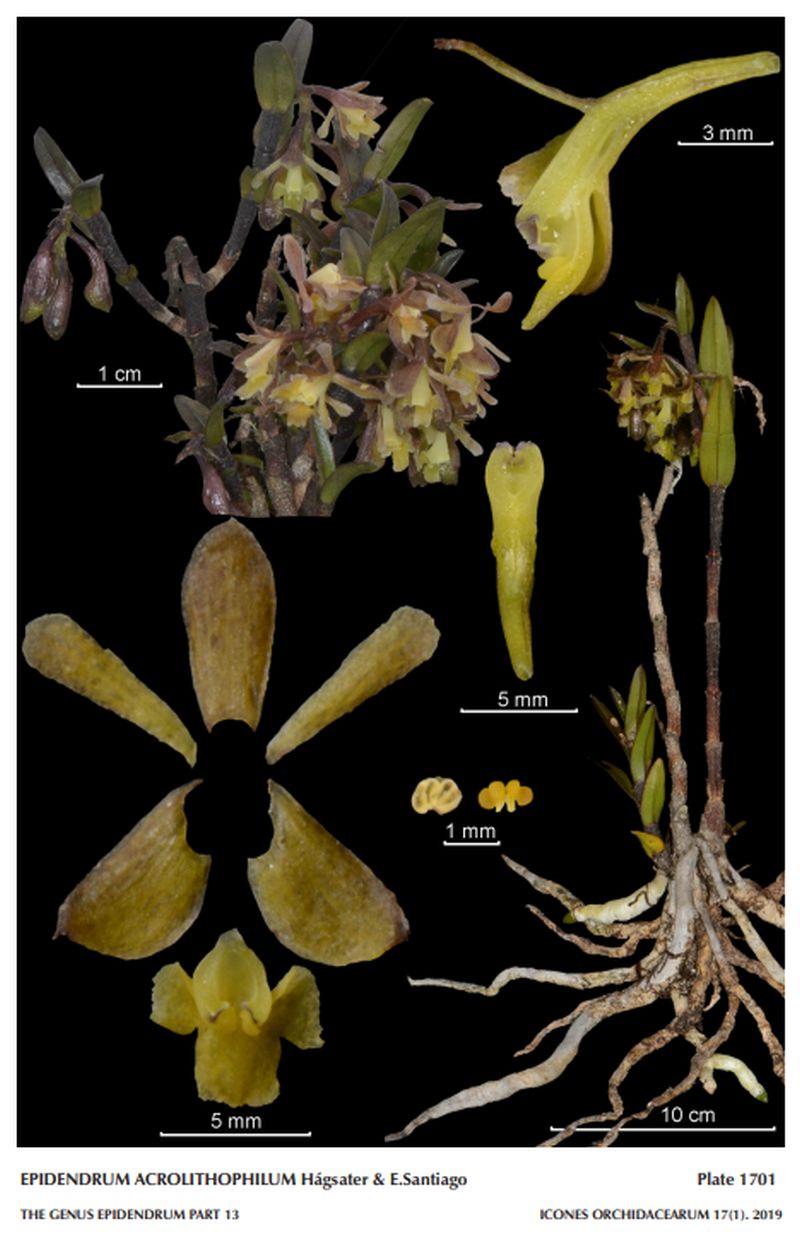

Epidendrum acrolithophilum Hagsater and Santiago 2019 GROUP Andean SUBGROUP Moritzii
Plant in situ Photo LCDP Photo by © E. Hágsater & A. Cisneros /TYPE Photo E Hagsater and AMO Herbaria Website





Common Name The High Elevation Stone Loving Epidendrum
Flower Size .6" [1.5 cm]
Found in Azuay, Loja and El Oro provinces of Ecuador at the summit of the Cordillera Occidental in the provinces of in southern Ecuador and neighboring Piura and Cajamarca departments in Peru, on the summit of the cordillera in paramo, growing on large boulders in very windy, cold, wet conditionswith lichens, at elevations of 2700 to 3500 meters as a mniature to small sized, cold growing lithophyte with cane-like, branching above, terete, thin, straight basal stems, branches short, produced from the upper internodes of the basal stems, and themselves short branched stems, covered at the base by some foliar sheaths and carrying 10 to 15, distributed throughout the stems in young plants, 2 to 5 persistent along the apical half of the branches, articulate, coriaceous, parallel to the stems, imbricating; sheaths tubular, rugose, black-red when young, reddish brown when leaves fall, becoming scarious with age; blade narrowly lanceolate, apex acute, minutely apiculate, margin crenate, spreading leaves taht blooms in the spring, summer and fall on a terminla, without a spathe, peduncle .12" [3 mm] long, terete, thin, without bracts; rachis .48 to .68" [1.2 to 1.7 mm] long, hidden by the flowers, .6 to .8" [1.5 to 2.0 cm] long overall, apical, racemose, arching-nutant, densely, simultaneously 7 to 12 flowered inflorescence with half as long as the ovary, triangular-lanceolate, acuminate, embracing floral bracts and carrying resupinate flowers with no fragrance detected and the ovary and dorsal surface of sepals' brown, inner surface yellow-brown, petals and lip yellow, column yellow to yellowish brown with the apex tinged purple.
"Epidendrum acrolithophilum belongs to the GROUP Andean SUBGROUP Moritzii which is characterized by the sub-monopodial, branching habit, adpressed leaf-sheaths, acute leaves, and 3-lobed lip. The new species is recognized by the short, compact, bushy plants to 8" [20 cm] tall, leaves .4 to .92" x .08 to .28" [1.0 to 2.3 x 0.2 to 0.7 cm], lanceolate and nearly parallel to the stems, inflorescence .6 to .8" [1.5 to 2.0 cm] long, 7 to 12 yellowish brown flowers with the lip yellow, sepals .272 to .28" [6.8 to 7.0 mm] long, lip .22 x .22" [5.5 x 5.5 mm], 3-lobed, the lateral lobes dolabriform, and mid-lobe sub-quadrate. Epidendrum tenuicaule Lindl. is also bushy with branching stems to 20" [50 cm] tall, leaves .6 to 2" x .08 to .2" [1.5 to 5.0 x 0.2 to 0.5 cm], narrowly lanceolate, somewhat spreading from the stems, inflorescence 1 to 1.48" [2.5 to 3.7 cm] long, 16 to 20 flowers greenish yellow, lip .152 x .2" [3.8 x 5.0 mm], mid lobe rectangular, longer than broad. Epidendrum scabrum Ruiz & Pavón has very tall monopodial stems, much larger, wider leaves, to .52" [13 mm] wide, with a relatively large, somewhat paniculate, arching-nutant, many-flowered inflorescence 2.6" [6.5 cm] long, flowers yellow, sepals .4 x 1.12" [10 x 2.8 mm], and lip 1.88 x .232" [4.7 x 5.8 mm]. Epidendrum scabrum var parviflorum Cogn. has leaves 1 to 1.2" [2.5 to 3.0 cm] long, lanceolate, nearly parallel to the stem, 16 flowers, color not known, sepals .2 to .24" [5 to 6 mm] long, lip .12 to .16" [3 x 4 mm], the mid-lobe trapezoid, minutely apiculate." Hagsater etal 2018
Synonyms
References W3 Tropicos, Kew Monocot list , IPNI ; Icones Orchidacearum 8 Plate 886 Hagsater & Santiago 2006 as E scabrum not drawing fide for E acrolithphilum; * Icones Orchidacearum 17(1) Plate 1701 Hagsater & Jimenez 2019 drawing/photo fide
--------------------------------------------------------------------------------------------------------------------------